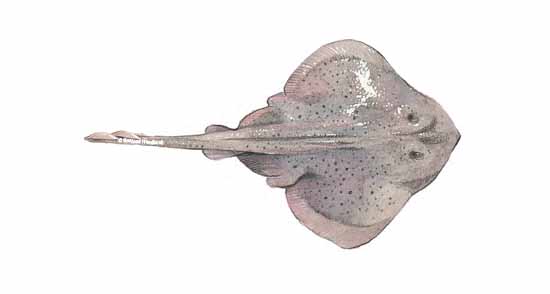Spinytail Skate, Bathyraja spinicauda
This skate has a smooth body, devoid of spines, but its tail is thorny, with a row of 21–26 spines extending down the middle, one of which occurs between the two dorsal fins. The spinytail skate is distinguished from other skate species within its range by its possession of a flabby, flexible snout – a consequence of thin and flimsy, rather than rigid, cartilage support. This soft snout is a characteristic of the genus. The upper body of the spinytail is a light grey, while the undersurface is white with grey around the edges and on the lower tail region. It reaches 172 cm in size.
The spinytail skate is not common throughout much of its North Atlantic range, from the Davis Strait and Labrador in the west, to northwestern Europe and the Barents Sea in the east. It occurs on the ocean floor at depths of 120–800 m, where it feeds opportunistically on a myriad of bottom organisms including thorny skates and capelin. It is classified as an omnivore.
Perhaps the most unusual feature of this fish is its horny egg capsule, which is covered in minute hair-like structures. Numbering 30,000 on each side, these neatly arranged, closely packed structures impart a velvety texture to the capsule. The embryo of this fish develops within this protective case for 12 months.

